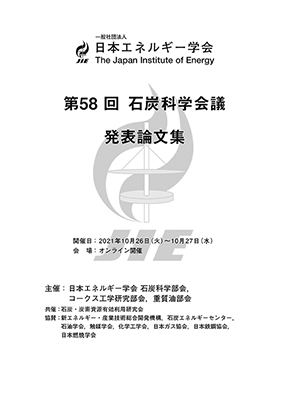第58回石炭科学会議
選択された号の論文の40件中1~40を表示しています
- |<
- <
- 1
- >
- >|
開催案内・プログラム
-
p. 0_1-0_2
発行日: 2021/10/19
公開日: 2021/11/08
PDF形式でダウンロード (263K) -
p. 0_3-0_5
発行日: 2021/10/19
公開日: 2021/11/08
PDF形式でダウンロード (260K)
招待講演・特別講演
-
p. ii-xi
発行日: 2021/10/19
公開日: 2021/11/08
PDF形式でダウンロード (631K) -
p. xii-xxi
発行日: 2021/10/19
公開日: 2021/11/08
PDF形式でダウンロード (713K) -
p. xxii-xxix
発行日: 2021/10/19
公開日: 2021/11/08
PDF形式でダウンロード (1635K) -
p. xxx-xxxvi
発行日: 2021/10/19
公開日: 2021/11/08
PDF形式でダウンロード (629K)
研究発表
熱分解・コークス、改質・処理・クリーン化
-
p. 2-3
発行日: 2021/10/19
公開日: 2021/11/08
PDF形式でダウンロード (687K) -
p. 4-5
発行日: 2021/10/19
公開日: 2021/11/08
PDF形式でダウンロード (604K) -
p. 6-7
発行日: 2021/10/19
公開日: 2021/11/08
PDF形式でダウンロード (809K) -
p. 8-9
発行日: 2021/10/19
公開日: 2021/11/08
PDF形式でダウンロード (765K)
ガス化、灰・微量元素、バイオマス
-
p. 10-11
発行日: 2021/10/19
公開日: 2021/11/08
PDF形式でダウンロード (671K) -
p. 12-13
発行日: 2021/10/19
公開日: 2021/11/08
PDF形式でダウンロード (953K) -
p. 14-15
発行日: 2021/10/19
公開日: 2021/11/08
PDF形式でダウンロード (558K) -
p. 16-17
発行日: 2021/10/19
公開日: 2021/11/08
PDF形式でダウンロード (756K)
バイオマス、熱分解・コークス
-
p. 18-19
発行日: 2021/10/19
公開日: 2021/11/08
PDF形式でダウンロード (557K) -
p. 20-21
発行日: 2021/10/19
公開日: 2021/11/08
PDF形式でダウンロード (925K) -
p. 22-23
発行日: 2021/10/19
公開日: 2021/11/08
PDF形式でダウンロード (535K)
改質・処理・クリーン化、カーボンリサイクル
-
p. 24-25
発行日: 2021/10/19
公開日: 2021/11/08
PDF形式でダウンロード (531K) -
p. 26-27
発行日: 2021/10/19
公開日: 2021/11/08
PDF形式でダウンロード (615K) -
p. 28-29
発行日: 2021/10/19
公開日: 2021/11/08
PDF形式でダウンロード (907K) -
p. 30-31
発行日: 2021/10/19
公開日: 2021/11/08
PDF形式でダウンロード (564K)
構造・物性、重質油
-
p. 32-33
発行日: 2021/10/19
公開日: 2021/11/08
PDF形式でダウンロード (741K) -
p. 34-35
発行日: 2021/10/19
公開日: 2021/11/08
PDF形式でダウンロード (958K) -
p. 36-37
発行日: 2021/10/19
公開日: 2021/11/08
PDF形式でダウンロード (651K) -
p. 38-39
発行日: 2021/10/19
公開日: 2021/11/08
PDF形式でダウンロード (1123K)
灰・微量元素
-
p. 40-41
発行日: 2021/10/19
公開日: 2021/11/08
PDF形式でダウンロード (594K) -
p. 42-43
発行日: 2021/10/19
公開日: 2021/11/08
PDF形式でダウンロード (613K) -
p. 44-45
発行日: 2021/10/19
公開日: 2021/11/08
PDF形式でダウンロード (383K)
ガス化・燃焼 1
-
p. 46-47
発行日: 2021/10/19
公開日: 2021/11/08
PDF形式でダウンロード (1045K) -
p. 48-49
発行日: 2021/10/19
公開日: 2021/11/08
PDF形式でダウンロード (609K) -
p. 50-51
発行日: 2021/10/19
公開日: 2021/11/08
PDF形式でダウンロード (655K) -
p. 52-53
発行日: 2021/10/19
公開日: 2021/11/08
PDF形式でダウンロード (808K)
ガス化・燃焼 2
-
p. 54-55
発行日: 2021/10/19
公開日: 2021/11/08
PDF形式でダウンロード (662K) -
p. 56-57
発行日: 2021/10/19
公開日: 2021/11/08
PDF形式でダウンロード (566K) -
p. 58-59
発行日: 2021/10/19
公開日: 2021/11/08
PDF形式でダウンロード (679K) -
p. 60-61
発行日: 2021/10/19
公開日: 2021/11/08
PDF形式でダウンロード (813K)
ガス化
-
p. 62-63
発行日: 2021/10/19
公開日: 2021/11/08
PDF形式でダウンロード (659K) -
p. 64-65
発行日: 2021/10/19
公開日: 2021/11/08
PDF形式でダウンロード (675K) -
p. 66-67
発行日: 2021/10/19
公開日: 2021/11/08
PDF形式でダウンロード (710K) -
p. 68-69
発行日: 2021/10/19
公開日: 2021/11/08
PDF形式でダウンロード (660K)
- |<
- <
- 1
- >
- >|
